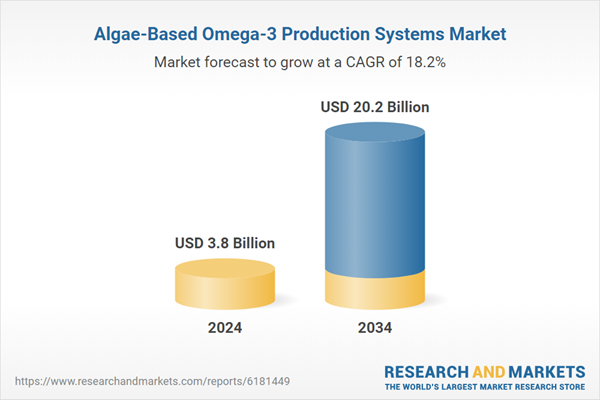This growth is driven by rising consumer demand for sustainable, plant-based omega-3 fatty acids as alternatives to traditional fish oil. With increasing health awareness, environmental concerns, and dietary restrictions, more individuals are turning toward algae-derived omega-3s, which meet clean-label standards and avoid allergens. Advances in algal biotechnology, including closed-loop systems and photobioreactors, are significantly enhancing production efficiency and scalability. These systems enable higher biomass yields and offer a controlled environment that minimizes contamination risks and ensures product consistency. Consumers are pushing companies to deliver transparent, allergen-free products that align with eco-conscious values. The rising popularity of herbal and plant-based health supplements is evident in the U.S., with an annual 5.4% growth in the herbals category, which continues to support demand for algae-derived omega-3. As the global wellness trend grows stronger, companies are racing to innovate in both technology and product formulation to meet this rising demand.
The heterotrophic fermentation systems segment held 64.4% share and is projected to maintain a CAGR of 18.2% through 2034. These systems have proven to be the most viable and scalable method for commercial algae-based omega-3 production. Operating under controlled conditions, heterotrophic fermentation allows algae to metabolize carbohydrate sources such as glucose, sucrose, or industrial byproducts for optimal omega-3 yield. Their industrial-scale compatibility and reduced risk of environmental contamination have positioned them as the backbone of production for key industry players.
The dietary supplements segment held a 31.7% share in 2024 and is gaining traction as more consumers prioritize plant-based health products. This segment benefits from strong retail networks, trusted brand names, and attractive margins, which make it a primary application area for algae-derived omega-3s. The increased awareness of omega-3's health benefits, particularly in cardiovascular, cognitive, and inflammatory health, is further supporting supplement uptake.
North America Algae-Based Omega-3 Production Systems Market is forecast to grow at a CAGR of 18.3% between 2025 and 2034, driven by a health-conscious consumer base and increasing adoption of plant-forward lifestyles. Innovations centered around non-GMO, organic, and environmentally friendly formulations continue to attract attention from consumers seeking sustainable wellness solutions.
Leading companies operating in the Global Algae-Based Omega-3 Production Systems Market include DSM-Firmenich, Fermentalg, Cellana Inc., Algatech, CABIO Biotech, Evonik Industries AG, Nuseed, Corbion N.V., Algisys, Qualitas Health, and Mara Renewables Corporation. Companies in the Global Algae-Based Omega-3 Production Systems Market are pursuing multiple strategies to secure and grow their market share. Key players are heavily investing in R&D to improve strain selection and boost lipid yield, while optimizing production technologies like heterotrophic fermentation for cost-effective scalability. Collaborations with nutrition and pharmaceutical brands help expand distribution channels and increase product visibility. Firms are also working toward obtaining clean-label certifications and aligning with non-GMO, allergen-free, and vegan-friendly standards to capture niche markets.
Comprehensive Market Analysis and Forecast
- Industry trends, key growth drivers, challenges, future opportunities, and regulatory landscape
- Competitive landscape with Porter’s Five Forces and PESTEL analysis
- Market size, segmentation, and regional forecasts
- In-depth company profiles, business strategies, financial insights, and SWOT analysis
This product will be delivered within 2-4 business days.
Table of Contents
Companies Mentioned
The companies profiled in this Algae-Based Omega-3 Production Systems market report include:- Algatech
- Algisys
- CABIO Biotech
- Cellana Inc
- Corbion N.V.
- DSM-Firmenich
- Evonik Industries AG
- Fermentalg
- Mara Renewables Corporation
- Nuseed
- Qualitas Health
Table Information
| Report Attribute | Details |
|---|---|
| No. of Pages | 210 |
| Published | October 2025 |
| Forecast Period | 2024 - 2034 |
| Estimated Market Value ( USD | $ 3.8 Billion |
| Forecasted Market Value ( USD | $ 20.2 Billion |
| Compound Annual Growth Rate | 18.2% |
| Regions Covered | Global |
| No. of Companies Mentioned | 12 |









